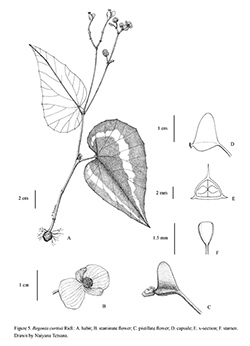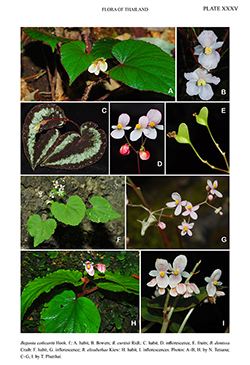e-Flora of Thailand
Volume 14 > Part 3 > Year 2019 > Page 372 > Begoniaceae > Begonia
9. Begonia curtisii Ridl.wfo-0000823777
[§ Parvibegonia], J. Straits Branch Roy. Asiat. Soc. 59: 106. 1911; Irmscher, Mitt. Inst. Allg. Bot. Hamburg 8: 149. 1929; Craib, Fl. Siam. 1: 772. 1931; Hughes, Annot. Checkl. SE Asian Begonia. 55. 2008. Fig. 5. Plate XXXV: C–E.
Accepted Name : This is currently accepted.
Description : Monoecious caulescent herb, 25−30 cm tall. Stems succulent, erect, glabrous, dark red, tubers asymmetric globose with numerous fibrous roots, 5−15 mm diam. Stipules persistent, pale red or pale green with dark red stripes, elliptic-oblong, 7−10 by 3−5 mm, apex acute, margin ciliate. Leaves pendent; alternate; petiole dark red, 10−80 mm long, lamina basifixed, succulent, asymmetric, chartaceous when dry, adaxial surface glabrous, dark grey almost black with falcate silver maculation towards tip or dull dark green with small patches (or spots) of silver maculation, abaxial surface glabrous, dark reddish, ovate, 6.5−13 by 2.5−8 cm, base cordate, apex acuminate, margin shallowly dentate with a fringe of multicellular hairs or ciliolate, venation palmate-pinnate, veins 4−5, midrib prominent beneath. Inflorescences terminal, bisexual, 7.5−10 cm long, dichasium, 1−2 branches; containing 6 staminate flowers and 2 pistillate flowers per branch, staminate flowers opening first; peduncle pale green or dark red, 4.5−7 cm long, terete, glabrous. Bracts caducous, pale green with red stripes, membranous, ovate-oblong, oblong, 5−7 by 2−4 mm, apex acute or obtuse, margin entire. Staminate flowers: pedicels pale green, 5−10 mm, erect, glabrous; tepals 4 (2), whitish inside and reddish orange outside in upper tepal, outer 2 obovate, 6−7 by 5−7 mm, base cuneate, rounded, apex rounded, margin slightly entire, glabrous on both sides, inner 2 ovate lanceolate, 4−5 by 2−3 mm, base cuneate, apex acute, margin entire, glabrous on both sides; androecium actinomorphic, globose, stamens ca 60, yellow, filaments ca 0.8 mm long, anthers, obdeltoid, ca 0.7 mm long, dehiscing by longitudinal slits near tip, fused at base. Pistillate flowers: pedicels pale green, ca 13 mm long; tepals (2−)4, whitish inside and reddish orange outside in upper tepal, outer 2 obovate, 6−7 by 5−7 mm, base rounded, apex rounded, margin entire, glabrous on both sides, inner 2 ovate lanceolate, 4−5 by 2−3 mm, base cuneate, apex acute, margin entire, glabrous on both sides; styles 2, fused at base, once spirally twisted, yellow, stigmatic band kidney-shaped, spiral; ovary with 3 subequal wings, pale green, 2-locular, placentae bilamellate. Fruit a dehiscent capsule, nodding, pale green, pendulous, drying pale brown, 10 by 8−9 mm; locules oblong, 5−6 by 3−4 mm; abaxial wing symmetrically ligulate, 7−8 mm long, lateral wings narrower, curved along capsule, 2−3 mm long. Seeds brown, ellipsoidal, 0.4−0.5 mm long, collar cells ca 2/4 length of seed.
Thailand : PENINSULAR: Phangnga, Surat Thani (Kasum – type: Curtis 3234, syntype -K SING).
Distribution : Endemic.
Ecology : On wet limestone hills in rock crevices, 0−50 m alt. Flowering: May–November; fruiting: November–January.
Vernacular : Kam kung hin (ก้ามกุ้งหิน).
Notes: Begonia curtisii is close to B. integrifolia and has been considered a synonym of this species (Kiew, Begonias Pen. Mal. 74. 2005), however, the pistillate flower looks much like the staminate flower in having 4 (not 5) tepals and two lateral wings on the fruit that do not expand. They are narrow and curved along the capsule, moreover the adaxial wing is symmetrically ligulate, not triangular. This species is confined to isolated limestone outcrops in Phangnga-Surat Thani, an area with high levels of local endemism.


